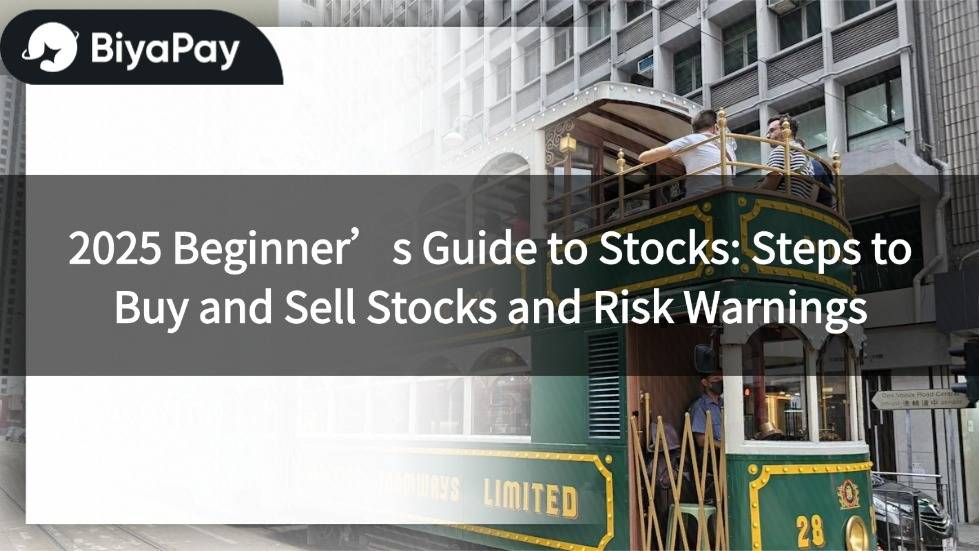- EasyCard
- Trade
- Help
- Announcement
- Academy
- SWIFT Code
- Iban Number
- Referral
- Customer Service
- Blog
- Creator
2025 Beginner’s Guide to Stocks: Steps to Buy and Sell Stocks and Risk Warnings

Image Source: unsplash
You might ask, how should you safely start with stocks? In fact, the most important thing for beginners is to proceed step by step and understand the practical operations of each step. You should always remember that risk management is equally important. When you actively think through every detail, you can more easily avoid common mistakes. This article will use simple language to help you master the basic essentials of stock investing step by step.
Steps to Start with Stocks

Image Source: pexels
Opening a Securities Account
To start with stocks, the first step is to open a securities account. You can choose from Hong Kong banks, traditional brokerage firms, or online brokers.
- Hong Kong banks such as HSBC and Hang Seng Bank offer securities account services, suitable for those who prefer face-to-face service.
- Traditional brokerage firms have dedicated staff to help you understand the stock investment process.
- Online brokers like Futu and Bright Smart have faster account opening processes and lower fees, suitable for those accustomed to online operations.
When opening an account, you need to prepare identification documents (e.g., Hong Kong ID card), proof of address (e.g., bank statements), and bank account details. You should note that different brokers have varying minimum deposit requirements and fees. You should compare the services and fees of different platforms to choose the most suitable securities account for yourself.
Tip: Before opening an account, understand the broker’s trading platform interface and customer service quality, as this will affect your future trading experience.
Fund Preparation
Before starting with stocks, you need to plan your funds. It’s recommended to set aside at least 6 months of living expenses as an emergency reserve, and use the remaining idle funds for stock investments. You can transfer funds to your securities account via bank transfer or online deposit methods.
- Based on recent A-share market data, experts using the “Stock Fund Flow Strength” model found that fund liquidity significantly impacts stock price volatility. You can refer to the fund flow strength index to assess market liquidity and decide when to increase or reduce positions.
- Although there’s no clear data on investment allocation ratios, you should allocate funds based on your risk tolerance and avoid investing all your funds at once.
Advice: You should periodically review your fund allocation and adjust your holdings appropriately during market volatility to reduce risks.
Stock Market Knowledge
You need to learn basic stock market knowledge, including what stocks are, how to calculate profits and losses, common investment types, and terminology.
- Stocks are ownership certificates issued by companies, and buying stocks means becoming a shareholder of the company.
- You need to learn to distinguish between market orders, limit orders, and other order types.
- Common terms such as “blue-chip stocks,” “price-to-earnings ratio,” and “trading volume” are essential knowledge for analyzing stocks in the future.
According to stock market books and surveys, many beginners are unfamiliar with basic questions like “what are stocks” or “what is the Dow Jones Industrial Average.” This reflects a significant knowledge gap among beginners in basic stock market terms and concepts. You should proactively learn these foundational concepts to improve your investment judgment.
Stock Selection Methods
Stock selection is a crucial step in starting with stocks. You should prioritize large, well-known companies or industries you are familiar with.
- Peter Lynch’s stock selection experience shows that investing in large, well-known companies like Apple or Gap and holding them long-term can yield significant returns.
- Investing in companies you are familiar with allows you to quickly grasp market information and reduce risks due to information asymmetry.
You don’t need to pursue complex stock selection strategies. For beginners, choosing transparent, stable-performance companies can increase the success rate of investments. You can observe your daily life and choose brands you frequently encounter or understand as your starting point.
Tip: You can create a simple stock watchlist and regularly track company news and performance changes.
Order Placement Process
Once you’ve selected a stock, you can proceed with placing an order. You need to understand the difference between market orders and limit orders:
- Market Order: Executes at the current market price, suitable for those who want to buy or sell immediately.
- Limit Order: You can set the buy or sell price, and the transaction will only occur when the market price reaches your set price, suitable for those who want to control trading costs.
You can place orders through online trading platforms or mobile apps. Most platforms offer simulated trading functions to help you familiarize yourself with the order placement process.
Settlement and Position Management
After placing an order, you need to understand the settlement system. The Hong Kong stock market generally uses a T+2 system, meaning settlement is completed on the second business day after the trading day. You must ensure your securities account has sufficient funds to avoid transaction failures due to insufficient funds.
Position management is equally important. You should regularly check your portfolio and adjust fund allocation based on market conditions. Changes in the fund flow strength index can help you assess market liquidity and make decisions on increasing, reducing, or stopping losses. These disciplined operations help you build good liquidity management habits during the stock market entry phase.
Note: You should maintain fund liquidity and avoid over-concentrating investments in a single stock to ensure you have enough cash to handle unexpected situations.
Trading Practical Details
Trading Fees
When buying and selling stocks, you must pay attention to the fees, commissions, and custody fees charged by different brokers. These fees directly affect your investment returns. Taking Interactive Brokers (IB) as an example, the broker offers tiered and fixed fee structures. You can refer to the table below:
| Fee Type | Tiered Fee | Fixed Fee |
|---|---|---|
| Per Share Rate | From USD 0.0035 | USD 0.005 |
| Minimum Fee | USD 0.35 | USD 1 |
| Suitable Trading Volume | Above 100 shares | Above 200 shares |
If you buy 100 U.S. shares, the tiered fee is USD 0.0035 per share, totaling USD 0.35, meeting the minimum fee. The fixed fee is USD 0.005 per share, with a minimum fee of USD 1. Different brokers also charge regulatory fees, exchange fees, and clearing fees. You should compare fee structures across platforms and choose brokers with transparent and lower fees to reduce unnecessary expenses.
Tip: You should regularly check the broker’s latest fee announcements to avoid increased costs due to fee adjustments.
Trading Hours
You need to understand the trading hours of major markets to seize the best buying and selling opportunities. Taking Hong Kong, U.S., European, and Tokyo markets as examples, trading volumes and price volatility vary across different time periods:
| Market Name | Taiwan Time Trading Hours | Trading Volume Characteristics | Price Volatility Characteristics | Market Activity Description |
|---|---|---|---|---|
| Tokyo Market | 7:00–16:00 | Low | Small | Low liquidity in the morning, prone to wider spreads |
| European Market | 14:00–23:00 | High | High | Most active from 21:00–23:00, overlapping with the U.S. market |
| U.S. Market | 20:00–5:00 | High | High | Significant volatility during major economic data releases |
You can trade in the Hong Kong market from 9:00–13:30 on weekdays. The U.S. market opens at night, suitable for overnight operations. You should note that high trading volume and significant price volatility occur during active market periods, suitable for short-term trading. During low liquidity periods, bid-ask spreads may widen, increasing trading risks.
Order Placement Methods
When placing orders, you mainly have two options: market orders and limit orders. Market orders execute immediately at the current market price, suitable for those who want to complete trades quickly. Limit orders allow you to set a desired price, and the transaction occurs only when the market price reaches your set price, suitable for those who want to control trading costs.
- Market Order: Fast execution but may have price deviations.
- Limit Order: Price controllable but may not execute immediately.
When operating, you should familiarize yourself with the trading platform’s order placement interface. Most brokers offer simulated trading functions to help you practice the order placement process and reduce errors.
Trading Platform Selection
When choosing a trading platform, you should consider the following:
- Whether trading fees are transparent and reasonable
- Whether the platform interface is simple and user-friendly
- Whether customer service is timely
- Whether mobile apps are supported
You can try the platform’s demo account to experience the operation process. Choosing a suitable platform helps improve trading efficiency and reduce operational errors.
Note: You should regularly update the platform’s app to ensure trading security and full functionality.
Risks and Management

Image Source: pexels
Market Volatility
You will often encounter significant price fluctuations in the stock market. The market is influenced by economic data, policy news, international events, and more. You should understand that short-term price fluctuations are normal. You should not make impulsive decisions due to temporary volatility. You can set stop-loss levels to help control losses.
Emotions and Decision-Making
Your emotions can affect your judgment when investing. When the market rises, you may become overly optimistic and chase highs. When the market falls, you may panic and sell. You should learn to analyze calmly and not be swayed by emotions. You can create an investment plan and strictly follow it to reduce emotional impacts.
Overtrading
If you frequently buy and sell stocks, you may increase fees and commission expenses. Overtrading makes it hard to focus on long-term goals. You should regularly review your portfolio and avoid frequent trading due to short-term volatility. You can set monthly or quarterly portfolio checks to maintain discipline.
Leverage Risks
When you use leveraged products (e.g., Contracts for Difference, CFDs), the potential risks significantly increase. According to public data from the European Securities and Markets Authority:
- Approximately 76% of CFD trading accounts incur losses.
- The proportion of loss-making clients for most CFD brokers ranges between 65% and 85%.
- Excessive leverage is the main reason for most investors’ losses.
These data show that improper use of leverage can lead to greater loss risks. You should be particularly cautious with leveraged products and not pursue high returns while ignoring risks.
Risk Management Suggestions
You can adopt the following methods to manage investment risks:
- Diversify investments to avoid concentrating on a single stock or industry.
- Set stop-loss points to reduce losses early.
- Regularly review your portfolio and adjust strategies based on market changes.
- Invest only idle funds and retain sufficient cash for emergencies.
Tip: You should continuously learn investment knowledge and enhance risk awareness to develop steadily in the stock market over the long term.
As long as you follow each step and prioritize risk management, you can steadily start with stocks. You should continue learning new knowledge, make good use of various investment tools, and maintain rational analysis. Investing involves risks, and you should make judgments based on your own situation. You’re welcome to leave comments with questions or share your stock market entry experiences for mutual learning and exchange.
FAQ
What is the minimum amount needed to buy stocks?
You can start with approximately USD 100, with the actual amount depending on the stock price and broker requirements. You should pay attention to exchange rate changes and calculate deposit costs.
How long does it take to open an account?
You can generally complete online broker account opening within 1 to 3 business days. Opening an account with Hong Kong banks may take longer. You need to prepare identification and proof of address.
Is there a minimum transaction fee for buying and selling stocks?
Most brokers have a minimum transaction fee, such as USD 1 per trade. You should compare the fee schedules of different platforms.
Can stocks be sold at any time?
You can sell your held stocks during trading hours. You should note the opening hours of different markets.
How should beginners choose their first stock?
You can choose large, transparent companies, such as familiar brands. You should avoid high-risk or complex products.
Beginner stock trading requires solid account setup and risk management strategies, and an efficient digital financial platform can enhance your trading flexibility. BiyaPay offers a one-stop solution, enabling trading in U.S. and Hong Kong stocks without offshore accounts, helping you easily engage in global markets while leveraging the article’s stock selection and order placement techniques.
Supporting USD, HKD, and 30+ fiat and digital currencies with real-time exchange rate transparency, plus global remittances to 190+ countries with remittance fees as low as 0.5%. A 5.48% annualized yield savings product with no lock-in period balances stock trading’s volatility risks with liquidity. Sign up for BiyaPay today to combine beginner stock trading knowledge with BiyaPay’s low-cost financial tools for a steady, efficient investment journey!
*This article is provided for general information purposes and does not constitute legal, tax or other professional advice from BiyaPay or its subsidiaries and its affiliates, and it is not intended as a substitute for obtaining advice from a financial advisor or any other professional.
We make no representations, warranties or warranties, express or implied, as to the accuracy, completeness or timeliness of the contents of this publication.




Contact Us
Company and Team
BiyaPay Products
Customer Services
is a broker-dealer registered with the U.S. Securities and Exchange Commission (SEC) (No.: 802-127417), member of the Financial Industry Regulatory Authority (FINRA) (CRD: 325027), member of the Securities Investor Protection Corporation (SIPC), and regulated by FINRA and SEC.
registered with the US Financial Crimes Enforcement Network (FinCEN), as a Money Services Business (MSB), registration number: 31000218637349, and regulated by FinCEN.
registered as Financial Service Provider (FSP number: FSP1007221) in New Zealand, and is a member of the Financial Dispute Resolution Scheme, a New Zealand independent dispute resolution service provider.




















